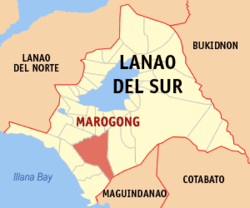Marogong
Marogong, officially the Municipality of Marogong, is a 4th class municipality in the province of Lanao del Sur, Philippines. According to the 2015 census, it has a population of 21,319 people.[3]
Marogong | |
|---|---|
| Municipality of Marogong | |
 Seal | |
 Map of Lanao del Sur with Marogong highlighted | |
OpenStreetMap 
| |
.svg.png) Marogong Location within the Philippines | |
| Coordinates: 7°40′N 124°09′E | |
| Country | |
| Region | Bangsamoro Autonomous Region in Muslim Mindanao (BARMM) |
| Province | Lanao del Sur |
| District | 2nd District |
| Founded | May 4, 1977 |
| Barangays | 24 (see Barangays) |
| Government | |
| • Type | Sangguniang Bayan |
| • Mayor | Nassif B. Maruhom |
| • Vice Mayor | Haroun T. Maruhom |
| • Congressman | Yasser A. Balindong |
| • Electorate | 11,698 voters (2019) |
| Area | |
| • Total | 365.00 km2 (140.93 sq mi) |
| Population (2015 census)[3] | |
| • Total | 21,319 |
| • Density | 58/km2 (150/sq mi) |
| • Households | 2,790 |
| Economy | |
| • Income class | 4th municipal income class |
| • Poverty incidence | 72.53% (2015)[4] |
| • Revenue (₱) | 75,276,076.85 (2016) |
| Time zone | UTC+8 (PST) |
| ZIP code | 9303 |
| PSGC | |
| IDD : area code | +63 (0)63 |
| Climate type | tropical climate |
| Native languages | Maranao Tagalog |
| Website | www |
Barangays
Marogong is politically subdivided into 24 barangays.
- Balut
- Bagumbayan
- Bitayan
- Bolawan
- Bonga
- Cabasaran
- Cahera
- Cairantana
- Canibongan
- Diragun
- Mantailoco
- Mapantao
- Marogong East
- Marogong Proper (Poblacion)
- Mayaman
- Pabrica
- Paigoay Coda
- Pasayanun
- Piangologan (Lilimo)
- Puracan
- Romagondong
- Sarang
- Cadayonan
- Calumbog
Climate
| Climate data for Marogong, Lanao del Sur | |||||||||||||
|---|---|---|---|---|---|---|---|---|---|---|---|---|---|
| Month | Jan | Feb | Mar | Apr | May | Jun | Jul | Aug | Sep | Oct | Nov | Dec | Year |
| Average high °C (°F) | 28 (82) |
28 (82) |
28 (82) |
29 (84) |
28 (82) |
27 (81) |
27 (81) |
27 (81) |
27 (81) |
27 (81) |
27 (81) |
28 (82) |
28 (82) |
| Average low °C (°F) | 22 (72) |
22 (72) |
22 (72) |
23 (73) |
23 (73) |
23 (73) |
22 (72) |
22 (72) |
22 (72) |
22 (72) |
23 (73) |
22 (72) |
22 (72) |
| Average precipitation mm (inches) | 236 (9.3) |
225 (8.9) |
244 (9.6) |
235 (9.3) |
304 (12.0) |
287 (11.3) |
200 (7.9) |
175 (6.9) |
158 (6.2) |
200 (7.9) |
287 (11.3) |
243 (9.6) |
2,794 (110.2) |
| Average rainy days | 24.3 | 22.3 | 26.0 | 27.2 | 28.3 | 27.2 | 25.8 | 24.8 | 22.2 | 25.4 | 27.2 | 25.8 | 306.5 |
| Source: Meteoblue [5] | |||||||||||||
Demographics
| Year | Pop. | ±% p.a. |
|---|---|---|
| 1980 | 6,633 | — |
| 1990 | 12,775 | +6.78% |
| 1995 | 13,765 | +1.41% |
| 2000 | 16,165 | +3.51% |
| 2007 | 21,120 | +3.76% |
| 2010 | 18,541 | −4.63% |
| 2015 | 21,319 | +2.69% |
| Source: Philippine Statistics Authority[3][6][7][8] | ||
History
The Municipality of Marogong was first created as a barangay on July 5, 1965, as part of the Municipality of Tubaran. 13 years after, this barangay was changed into a municipality by virtue of the signing of Presidential Decree (P.D.) No. 1131 dated May 4, 1977, signed into law by President Ferdinand Edralin Marcos, officially creating Barangay Marogong into a regular Municipality by separating it from the Municipality of Tubaran.[9]
Marogong Municipality was first ran by the appointment of Abdulmadid P. Maruhom, who was succeeded by his children Monara Bae, Amron (Arumpac) and Haroun (Actor), now the incumbent Municipal Mayor.[9]
Marogong was founded by a Sultan Abdulmadid P. Maruhom in 1954 when he explored the forest and settled in what would later become a small town and finally a regular municipality of Lanao del sur. Maruhom was the first appointed mayor and first elected mayor on January 30, 1980.[9]
References
- "Municipality". Quezon City, Philippines: Department of the Interior and Local Government. Retrieved 31 May 2013.
- "Province: Lanao del Sur". PSGC Interactive. Quezon City, Philippines: Philippine Statistics Authority. Retrieved 12 November 2016.
- Census of Population (2015). "ARMM – Autonomous Region in Muslim Mindanao". Total Population by Province, City, Municipality and Barangay. PSA. Retrieved 20 June 2016.
- "PSA releases the 2015 Municipal and City Level Poverty Estimates". Quezon City, Philippines. Retrieved 12 October 2019.
- "Marogong, Lanao del Sur : Average Temperatures and Rainfall". Meteoblue. Retrieved 27 January 2019.
- Census of Population and Housing (2010). "ARMM – Autonomous Region in Muslim Mindanao". Total Population by Province, City, Municipality and Barangay. NSO. Retrieved 29 June 2016.
- Censuses of Population (1903–2007). "ARMM – Autonomous Region in Muslim Mindanao". Table 1. Population Enumerated in Various Censuses by Province/Highly Urbanized City: 1903 to 2007. NSO.
- "Province of Lanao del Sur". Municipality Population Data. Local Water Utilities Administration Research Division. Retrieved 17 December 2016.
- http://acmaly88.page.tl/BRIEF-HISTORY.htm